
Here’s a rule that the LiveCareer team likes to stress over and over again: cover letters don’t need to be long.
But no matter how often we emphasize this point, there are plenty of other advice websites, life experiences, and gut instincts that push job seekers in the opposite direction. Even though we counsel applicants to keep it short, they still feel driven by the urge to go long.
And length isn’t the only concern—there are several popular moves that aren’t really required by modern cover letter standards. And in some cases, these extra flourishes and explanations can actually hold job seekers back. Before you submit your cover letter, look over this list and see if you can streamline your message by giving these items a trim.
1. A chatty, friendly, flowery introduction.
You’re applying for a job, not hawking miracle cures at the state fair. Yes, it’s a good idea to gain trust before you launch into a sales pitch, but in this particular format, a long introductory song and dance won’t be necessary.
Instead of polite pleasantries, compliments for the company, and apologies for wasting your reader’s time, just state your case. Name the position you’re applying for. Share how you found out about it. Then move on.
2. Lengthy personal background
You have a passion for this kind of work, and your strong feelings took hold at a very young age. So as you draft your letter, you have two choices:
- You can stop after this sentence.
- You can take your reader back in time to the moment you went to visit your grandfather in his office at the bank and you saw the giant doors on the vaults and you felt a glow of pride and fascination with this institution and you knew that you had a future in accounting and finance.
We recommend stopping after the first sentence. Like all effective writing, a great cover letter tells a story…but it’s a short story. Wrap it up fast so you can get to the good part: how you plan to help your employers run a successful business.
3. Qualitative remarks
When you need to register an opinion, stay positive. Never criticize, complain, vent, or offer excuses in a cover letter.
But even better, limit your opinions altogether. Opinions are like machines with lots of moving parts—the more gears and circuits they entail, the greater the chance of something going wrong. You don’t know your audience well enough to share your opinions and judgments as facts. So avoid making qualitative statements about this company, its competitors, or your former employers.
4. Adverbs
If you see any word that modifies a verb and ends in “ly,” take a closer look. Is this word contributing something vital to the meaning of your sentence? If it isn’t, take it out. And it probably isn’t.
5. Repetition
Mediocre cover letters almost always involve two or three repetitive phrases. If you see the same sentence repeated twice in a row using different words, reach for the delete key.
Tighten Your Letter & Get More Attention
Schedule more interviews by getting directly to the point and making your case within three to four short paragraphs. For help with the cover letter editing and streamlining process, access the writing tools and templates available on LiveCareer.






